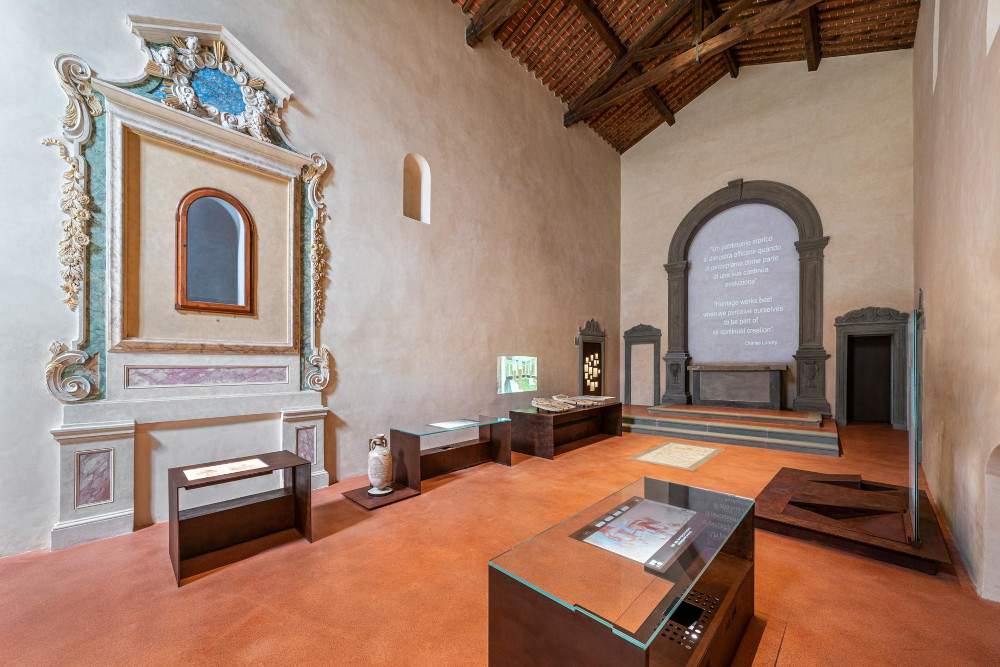Pistoia, San Salvatore Museum opens after two centuries of neglect and lengthy restoration
After two centuries of neglect and thanks to the intervention of Fondazione Caript, the Museum of San Salvatore will open to the public from September 24, 2022. One of the oldest churches in Pistoia, which has been recorded since the 10th century, has become the exhibition venue of Pistoia Musei, the fourth after Palazzo Buontalenti, Palazzo de’ Rossi and Antico Palazzo dei Vescovi.
“After a long restoration work financed by Fondazione Caript,” said Monica Preti, director of Pistoia Musei, “the building presents itself fully recovered and ready to begin a different phase of its history. A history that has led it to change its intended use to be once again a ’living’ place in the social fabric of the city, to which it is finally returned as a cultural and museum space. The layout, concentrated in one large space, succeeds in engaging the visitor in a narrative that unravels, around the stratifications, works, legends and religious rituals, for stops for personal exploration or true narratives.”
In 1784 Bishop Scipione de’ Ricci chose to suppress the parish of San Salvatore, which was then closed to worship in 1807. It began from that moment for the church a decline that was halted thanks to recovery by Fondazione Caript.
In agreement with the Cathedral Church of Pistoia, the owner of the property, the church of San Salvatore is reborn as a museum, offering a journey through the history of the city’s oldest nucleus through the display of works hitherto kept in the deposits of the Civic Museums.
“The investment in the museum of San Salvatore,” said Lorenzo Zogheri, president of Fondazione Caript, “is a significant step in a very challenging path for us, undertaken to preserve and enhance the local cultural and architectural heritage, in close collaboration with other city institutions. Its realization provides the Pistoia Musei circuit with its fourth location: a space that integrates into the rich panorama of historical and artistic beauties enclosed in the city’s historic center, telling its identity.”
Careful restoration work and excavations have brought to light the remains of the church’s earliest phases, revealed Roman and early medieval pre-existences. Part of the foundation pit of the first circle of walls from the Lombard period (8th century AD) has also been traced. New light is also being shed on the end of Catiline: according to legend, the Roman conspirator defeated in the Pistoian Apennines was buried at the foot of the church’s tabernacle, and today, it is the archaeological excavations that tell what was found on the very spot that belief dictates.
Among the most significant discoveries is that of an incomplete fresco, which art historian Giacomo Guazzini has recently studied in depth: the Lamentation over the Dead Christ, datable to the late 13th century and attributed to the circle of Lippo di Benivieni, an important painter documented in Florence between 1296 and 1320. Moving figures, characters with incisive and biting features, illusionistic devices: around the remains of this fresco brought to light by restoration, a narrative unfolds that can urge visitors to explore through images one of the most evocative themes in Tuscan painting of the period. Buried, in an earthenware jar, were found fragments of fabric and sponge, coins, ashes, and a tiny ivory die. Only through sophisticated analysis and historical sources have archaeologists been able to reconstruct a practice that probably dates back to a rededication rite celebrated in 1580.
“Whoever crosses the threshold,” comment Claudio Rosati and Nicola Becagli, heads of the museological and museographic project,“ first look at the architecture, its volume, lines and light. Notice the unusual configuration compared to other Romanesque churches in Pistoia and beyond: it has uncommon measurements, so much so that it appears wider than it is long. One hypothesis has it that the extent of the church is that set by the limits of the first circle of the city walls of which some traces are preserved on the south side. We hope that every visitor will find there a special atmosphere, such that it can be defined by the beautiful concept of spatialized feeling.”
The exhibition itinerary that St. Saviour’s offers to the public is a narrative that unfolds according to different levels of reading, and it is the visitor himself who chooses the degree of depth: in fact, the museum uses different languages to broaden the possibilities of the visit. A Braille path for people with visual impairments is being developed at the Region of Tuscany’s Braille Printworks and will soon be available in the museum.
Special attention is paid to the youngest children, with the intention of stimulating their curiosity and bringing them closer to cultural heritage through play. Two of the activities in the exhibition itinerary take inspiration from ancient games from the Roman era, which exploited very simple materials, such as pieces of wood and nuts. With some mosaic tiles, you can then make your own floor inspired by the one in the domus on display in the museum.
For info: www.pistoiamusei.it
Hours: Sunday, Sept. 25 to Friday, Sept. 30, 10 a.m. to 6 p.m. From Oct. 1, open Saturdays and Sundays from 10 a.m. to 6 p.m.
Image: San Salvatore Museum, Pistoia Musei, 2022. Photo by Ela Bialkowska, OKNO studio. Courtesy of Pistoia Musei.
 |
| Pistoia, San Salvatore Museum opens after two centuries of neglect and lengthy restoration |
Warning: the translation into English of the original Italian article was created using automatic tools. We undertake to review all articles, but we do not guarantee the total absence of inaccuracies in the translation due to the program. You can find the original by clicking on the ITA button. If you find any mistake,please contact us.





























